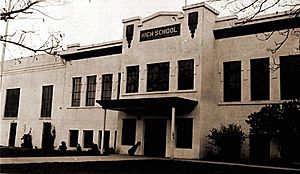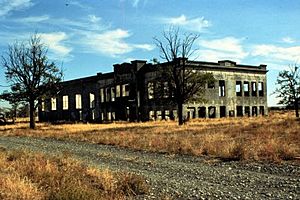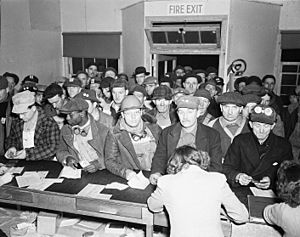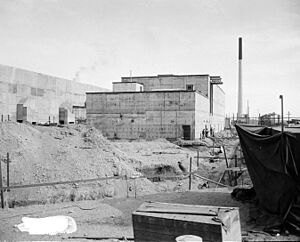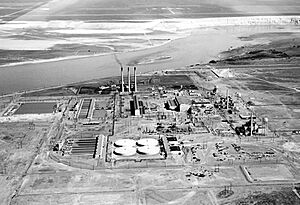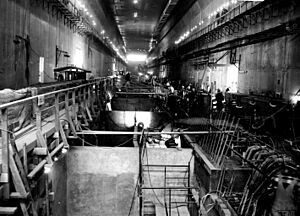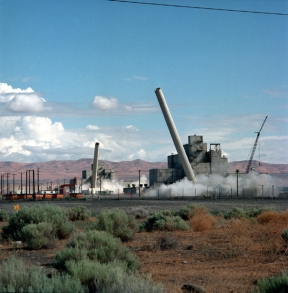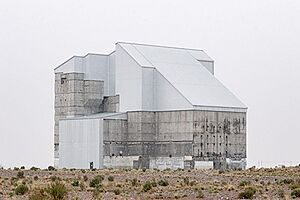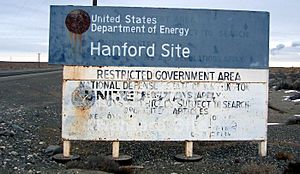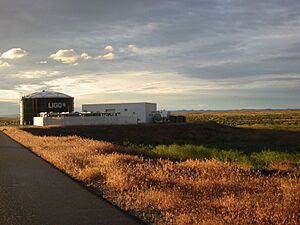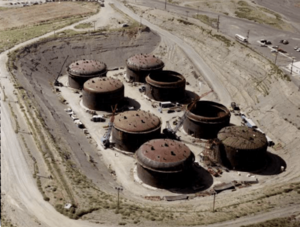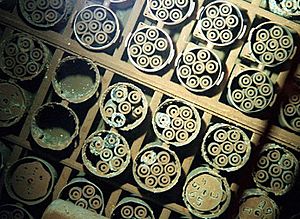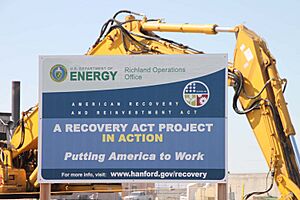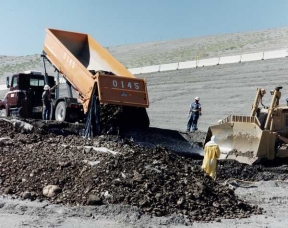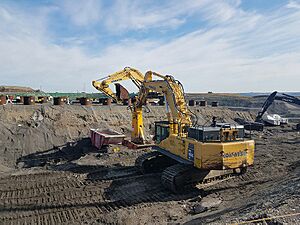Hanford Site facts for kids

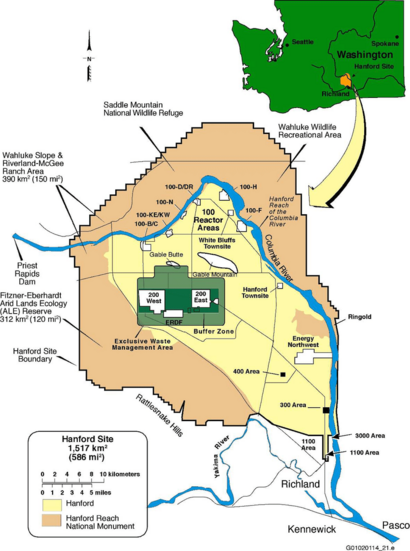
The Hanford Site was a special place in Washington where the U.S. government made nuclear materials. It's located on the Columbia River in Benton County. It was also known as Site W or the Hanford Nuclear Reservation.
Hanford was started in 1943 as part of the secret Manhattan Project during World War II. It was home to the Hanford Engineer Works and the B Reactor, which was the first large-scale reactor in the world to produce plutonium. This plutonium was used in the first atomic bomb, tested in the Trinity nuclear test, and in the Fat Man bomb dropped on Nagasaki.
During the Cold War, Hanford grew a lot. It had nine nuclear reactors and five large plants to process plutonium. This plutonium was used for most of the more than 60,000 nuclear weapons the U.S. built. Scientists at Hanford also made big advances in nuclear technology. The town of Richland, built for the project, became its own city in 1958.
Sadly, early safety rules and ways of getting rid of waste were not good enough. This caused a lot of radioactive materials to be released into the air and the Columbia River. This led to higher rates of cancer in the nearby areas. Because of this, the Hanford Site became the focus of the biggest environmental cleanup in the country. A group called the Hanford Advisory Board, made up of people from the community, helps decide what to do. The cleanup was still happening in 2023, with over 10,000 workers involved.
Today, Hanford is also home to a commercial nuclear power plant called the Columbia Generating Station. It has several places for scientific research, like the Pacific Northwest National Laboratory and the LIGO Hanford Observatory. In 2015, Hanford became part of the Manhattan Project National Historical Park. Visitors can even take tours to see the site and the B Reactor.
Contents
Hanford's Location and Nature
The Hanford Site covers about 586 square miles (1,518 km2). That's about half the size of Rhode Island! It's a desert area with very little rain, mostly covered by shrub-steppe plants. The Columbia River flows along the site for about 50 miles (80 km), forming its northern and eastern border.
The Columbia and Yakima Rivers here are home to fish like salmon, sturgeon, steelhead trout, and bass. You can also find skunks, muskrats, coyotes, raccoons, deer, eagles, hawks, and owls. The plants include sagebrush, bitterbrush, different kinds of grasses, prickly pear, and willow.
The original site was even bigger, about 670 square miles (1,735 km2). Some of this land has been returned to private use and now has farms and orchards. The site is next to the Tri-Cities area (Richland, Kennewick, and Pasco), where almost 300,000 people live. Hanford is a major source of jobs for these cities. In 2000, large parts of the original site became the Hanford Reach National Monument.
The rest of the site was divided into three main areas:
- The 100 Area: Where the nuclear reactors were built along the river.
- The 200 Area (Central Plateau): Where chemical plants separated plutonium.
- The 300 Area: Where support buildings were located.
Hanford's Weather
| Climate data for Hanford Site, Washington | |||||||||||||
|---|---|---|---|---|---|---|---|---|---|---|---|---|---|
| Month | Jan | Feb | Mar | Apr | May | Jun | Jul | Aug | Sep | Oct | Nov | Dec | Year |
| Record high °F (°C) | 72 (22) |
72 (22) |
83 (28) |
94 (34) |
104 (40) |
120 (49) |
113 (45) |
113 (45) |
106 (41) |
93 (34) |
76 (24) |
71 (22) |
120 (49) |
| Mean daily maximum °F (°C) | 40.0 (4.4) |
47.9 (8.8) |
58.1 (14.5) |
66.9 (19.4) |
76.9 (24.9) |
84.0 (28.9) |
93.6 (34.2) |
92.2 (33.4) |
81.8 (27.7) |
65.9 (18.8) |
49.2 (9.6) |
39.8 (4.3) |
66.4 (19.1) |
| Mean daily minimum °F (°C) | 26.5 (−3.1) |
28.9 (−1.7) |
34.5 (1.4) |
40.5 (4.7) |
48.9 (9.4) |
55.6 (13.1) |
62.5 (16.9) |
60.8 (16.0) |
52.2 (11.2) |
41.2 (5.1) |
31.6 (−0.2) |
26.0 (−3.3) |
42.4 (5.8) |
| Record low °F (°C) | −22 (−30) |
−23 (−31) |
5 (−15) |
21 (−6) |
28 (−2) |
37 (3) |
39 (4) |
41 (5) |
30 (−1) |
7 (−14) |
−13 (−25) |
−14 (−26) |
−23 (−31) |
| Average precipitation inches (mm) | 0.94 (24) |
0.64 (16) |
0.51 (13) |
0.47 (12) |
0.55 (14) |
0.53 (13) |
0.18 (4.6) |
0.25 (6.4) |
0.30 (7.6) |
0.57 (14) |
0.85 (22) |
0.99 (25) |
6.76 (172) |
| Source: Averages for 1991–2020, Extremes for 1945–2021 | |||||||||||||
Hanford holds the record for Washington state's highest temperature ever. It reached 120 °F (49 °C) on June 29, 2021.
Hanford's Early History
The area where the Yakima, Snake, and Columbia rivers meet has been a gathering place for native peoples for thousands of years. Archaeologists have found signs that Native Americans lived here over ten thousand years ago. Tribes like the Yakama, Nez Perce, and Umatilla used the land for hunting, fishing, and gathering food. Many ancient sites, including villages and hunting spots, have been found. Two of these sites were added to the National Register of Historic Places in 1976.
In 1855, Governor Isaac Stevens of the Territory of Washington tried to set up reservations for the Native American tribes. Treaties were signed, but they often didn't work well with the tribes' traditional ways of life. In 1858, a military group led by Colonel George Wright fought the tribes to make them follow the reservation system. Even so, Native Americans continued to use the area into the 1900s. The Wanapum people, for example, were never forced onto a reservation and lived along the Columbia River until 1943.
Later, settlers moved into the area, starting farms and orchards. But many of these farms failed during the Panic of 1893. The Reclamation Act of 1902 helped by having the government fund irrigation projects. This led to more people moving in, and small towns like Hanford, White Bluffs, and Richland were established. The Great Depression in the 1930s caused more farms to close. However, the building of the Grand Coulee Dam (1933-1942) and the Naval Air Station Pasco (1942) helped the local economy.
The Manhattan Project at Hanford
During World War II, the U.S. government started a secret project called the Manhattan Project. Its goal was to build an atomic bomb before Nazi Germany. Scientists at the University of Chicago studied a new element called plutonium. They believed plutonium could be used to create a powerful bomb. They worked on designing nuclear reactors to make plutonium and ways to separate it from other materials.
Choosing the Site
Brigadier General Leslie R. Groves Jr. became the director of the Manhattan Project in 1942. He hired DuPont, a company known for building explosives plants, to design and operate the plutonium factories. DuPont agreed to do the work for a fee of just one dollar, as they didn't want to profit from war.
DuPont was worried about building the reactors near Knoxville, Tennessee, where there were many people. A serious accident could harm many lives. They needed a very specific kind of place for the factories. The ideal site needed:
- Lots of clean water (at least 25,000 gallons per minute).
- A huge amount of electricity (about 100,000 kilowatts).
- A large, dangerous manufacturing area (at least 12 by 16 miles).
- Space for labs far from the reactors.
- A village for workers at least 10 miles upwind from the plant.
- No towns with more than a thousand people closer than 20 miles from the dangerous area.
- No main roads, railways, or villages closer than 10 miles from the dangerous area.
- Strong ground that could hold heavy buildings.
The most important thing was having enough electricity. Many war industries were already using a lot of power. So, they looked at places in the Pacific Northwest and Southwest that had extra electricity. In December 1942, a team inspected possible sites. They found that the Hanford Site was "far more favorable" than any other. They were especially impressed by a high-voltage power line from the Grand Coulee Dam that ran right through the site. General Groves visited in January 1943 and approved Hanford. The site became known as the Hanford Engineer Works (HEW) and was secretly called Site W.
Taking the Land
The government quickly took control of the land starting in February 1943. They needed to buy about 428,200 acres (1,733 km2), which was one of the biggest land purchases in U.S. history. Most of the land was sagebrush, used for grazing sheep. About 11% was farmland.
Farmers wanted to be paid for their crops as well as their land. Since construction couldn't start right away, General Groves let the farmers harvest their crops first. This helped the farmers and prevented food waste during wartime. Prisoners from the McNeil Island Penitentiary even helped with the harvest.
The crops in 1943 were very good, and war prices made land values go up. There were some disagreements over how much people should be paid. About 1,500 residents from Hanford, White Bluffs, and nearby areas had to move. The Wanapum people and other Native American tribes also had to leave their homes.
Native Americans used to fish in the Columbia River near White Bluffs every October. They dried the fish for winter food. They didn't want money, so a deal was made to let their chief and two helpers give out passes to fish. This was later stopped for security reasons. The Army promised to respect Native American graves, but it took 15 years for the Wanapum people to visit their cemeteries. In 1997, elders were allowed to bring children to the site once a year to learn about their sacred places.
Building the Workforce and Town
DuPont advertised for workers for a secret "war construction project" in Washington. They offered good pay and housing. For safety and security, workers couldn't live right on the plant site. So, two communities were built: a temporary camp for construction workers and a more permanent village for plant operators. They used existing villages, Hanford and Richland, to save time and money.
At its busiest, in June 1944, there were over 45,000 construction workers. About 13% were women, and 16.45% were non-white. African-American workers lived in separate areas, had their own dining halls, and were paid less than white workers. Housing included barracks, hutments (prefabricated plywood homes), and trailer parks.
The town of Richland was designed by G. Albin Pehrson. He wanted a modern community, but General Groves wanted something simpler. The final design was a compromise, which meant Richland had some issues like narrow roads and not enough stores for many years. Unlike other secret sites, Richland wasn't fenced off, so it had to be kept neat.
Building the Facilities

The nuclear facilities were built very quickly. By August 1945, the Hanford Engineer Works had built 554 buildings. These included three nuclear reactors (B, D, and F) and three plutonium processing plants. The project also needed 386 miles (621 km) of roads, 158 miles (254 km) of railway, and four electrical stations. They used a huge amount of concrete and steel.
Construction on the B Reactor started in August 1943 and finished by September 1944. The reactor began working in late September and produced its first plutonium on November 6, 1944. These reactors used graphite to control the nuclear reaction and water to cool them down. They were huge cylinders, 28 by 36 feet (8.5 by 11 m) and weighing 1,200 tons (1,089 tonnes). They had 2,004 aluminum tubes filled with uranium slugs. Cooling water was pumped through these tubes at 30,000 gallons per minute (1,900 L/s), enough water for a city of a million people.
How Plutonium Was Made
Uranium arrived at Hanford as metal bars. In the 300 Area, these bars were shaped into "slugs," which were cylindrical pieces about 1.5 inches (4 cm) wide and 8 inches (20 cm) long. Uranium reacts easily with water, so the slugs were covered in aluminum to protect them from the cooling water. If a cover broke, it could jam the reactor, so this process had to be perfect.
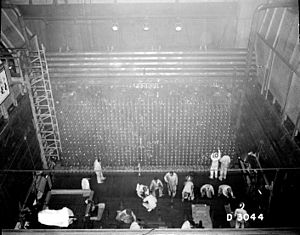
Used fuel slugs were moved by a special remote-controlled train to huge chemical separation plants about 10 miles (16 km) away. These buildings were massive, without windows, and had concrete walls 3 to 5 feet (0.9 to 1.5 m) thick. Inside, a series of chemical steps separated the tiny amount of plutonium from the remaining uranium and other radioactive materials.
Because the machinery became so radioactive, humans could never touch it. Engineers invented ways to replace parts using remote controls. Operators watched the process through periscopes and closed-circuit television. The radioactive waste from these plants was stored in "tank farms" with 64 underground tanks.
The first batch of plutonium was refined from December 1944 to February 1945. It was sent to the Los Alamos laboratory in New Mexico on February 5, 1945. Two other reactors, D Reactor and F Reactor, started working in December 1944 and February 1945. By March 1945, all three reactors were running at full power. By April, large amounts of plutonium were being sent to Los Alamos.
Production During the War
Reactors could be shut down very quickly, but they still produced heat from decaying radioactive materials. So, it was crucial that the cooling water never stopped flowing. If the power failed, steam pumps would automatically keep the water flowing. This happened on March 10, 1945, when a Japanese balloon bomb hit a power line. This caused a power surge, and the reactors automatically shut down. The bomb didn't explode, and the power line wasn't badly damaged. Hanford was the only U.S. nuclear facility to be attacked by an enemy.
Hanford made the plutonium for the bomb used in the 1945 Trinity nuclear test. The Manhattan Project was top-secret. Less than 1% of Hanford's workers knew they were building nuclear weapons. The existence of Hanford was made public on August 7 and 9, 1945, after the bombing of Hiroshima and before Hanford plutonium was used in the Fat Man bomb dropped on Nagasaki on August 9.
After the war, DuPont left the project. General Electric (GE) took over operations at Hanford on September 1, 1946. On December 31, 1946, the Manhattan Project ended, and the Atomic Energy Commission (AEC) took control of Hanford. The total cost of the Hanford Engineer Works up to that point was $348 million.
Hanford During the Cold War
GE faced big challenges at Hanford. Running the reactors constantly caused the Wigner effect, where the graphite inside the reactors would swell. This could damage the fuel tubes and shut down the reactors. Also, the process used to separate plutonium meant the uranium couldn't be reused. The AEC was worried about the supply of uranium.
Growth of Richland
The population of Richland grew quickly. In 1946, Hanford had about 4,500 workers. Two years later, it had over 8,600 workers. Richland grew from 14,000 people in 1947 to 22,000 in 1950. A new construction camp called North Richland was built, which had 13,000 people in 1948. Many workers also lived in Kennewick and Pasco.

Richland residents paid low rents for their homes. The town had a newspaper, the Richland Villager, which every resident received for free. Richland was a well-educated community, with many people having attended college. The average family income was higher than the national average, and very few families lived below the poverty line.
However, there were very few older people in Richland, as retirees had to give up their homes. The birth rate was very high, leading to many school-aged children. In 1950, there were only seven black people living in Richland. By 1960, this number grew to 189, making up 1.3% of the population. Black workers faced segregation in housing and recreation areas. Kennewick was known as a "sundown town," meaning black people had to leave by a certain time. Most black residents lived in a small, undeveloped area in Pasco.
The AEC wanted Richland to become a self-governing city. In 1953, they raised rents to match nearby communities. In 1955, residents voted against becoming their own city. However, Congress passed a law allowing government property in Richland to be transferred to the residents. People protested, but by July 1958, 4,200 homes had been sold. After getting promises that the AEC would help fund schools and services, the citizens of Richland voted to become their own city on December 12, 1958. In 1960, Richland won an All-America City Award.
Camp Hanford
During the war, military police guarded the Hanford Site. In 1947, GE security guards took over. The Army worried that all U.S. plutonium production was in one place, making it vulnerable. In 1950, the 5th Anti-aircraft Artillery Group arrived to protect against air attacks. They set up their headquarters in North Richland.
The military base was named "Camp Hanford" in 1951. They used large anti-aircraft guns and later Nike Ajax missiles. These missiles were replaced by Nike Hercules missiles. However, with the development of intercontinental ballistic missiles, these missiles became outdated. Camp Hanford closed on March 31, 1961.
Expanding Production
Tensions with the Soviet Union grew in 1948, leading to the Berlin Airlift. To increase plutonium production, the B Reactor was restarted. GE found ways to make the reactors more efficient. They added zirconium to the fuel covers to make them stronger. They also increased the power level of the reactors, which meant more plutonium was produced using less raw material.
The Soviet Union exploded its first atomic bomb in August 1949. In response, President Harry S. Truman ordered a crash program to develop the hydrogen bomb. This bomb needed large amounts of tritium. Hanford's H Reactor was chosen to produce tritium starting in 1950. The AEC also decided to build new reactors at a different site, which became the Savannah River Site.
The Korean War in 1951 led the AEC to approve a sixth reactor at Hanford. This was the C Reactor, which started working in November 1952. It was an improved version of the earlier reactors, with a higher power rating.
On February 25, 1952, Truman approved two more reactors at Hanford: K West and K East. These were much larger and known as "Jumbo" reactors. They used the same graphite-moderated technology but were improved to operate at 1,800 MW. Each needed 2,800 tons (2,540 tonnes) of graphite. They had fewer water pumps but could pump 125,000 gallons per minute (7,900 L/s). Heat from the cooling water was even used to warm the workplaces. These reactors were designed to last 20 years.
New Separation Plants
The AEC was not happy with the old plutonium separation process because it wasted uranium. GE developed a new process called REDOX, which used a solvent called hexone. The AEC approved it in 1949, and the new plant, called the S Plant, started operating in January 1952. It was 470 feet (143 m) long and 160 feet (49 m) wide, and could process much more uranium than the old plants. It also produced uranium as a byproduct. The S Plant operated until 1967.
Another process, PUREX (plutonium uranium reduction extraction), was developed. The PUREX Plant, or A Plant, started operating in 1955. It was even bigger, 1,000 feet (305 m) long. It operated from 1956 to 1972, and again from 1983 to 1988. The old B and T Plants were shut down after PUREX started.
During the 1940s, Hanford released about 400 curies of radioactive material into the Columbia River every day. This increased to 7,000 curies per day between 1951 and 1953, and peaked at 20,000 curies per day in 1959.
N Reactor
The Atomic Energy Act of 1954 shifted focus to nuclear power. By the late 1950s, the older reactors were getting old. In 1957, GE started planning a new reactor that would be clean, safe, and efficient, and could produce electricity as well as plutonium. Construction began in 1959. It started producing plutonium in 1964, and electricity in 1966.
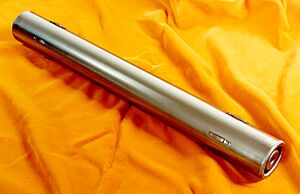
The N Reactor was the last of its kind and had many new features. It was the first American graphite-moderated power reactor and the first American dual-purpose reactor (making both plutonium and electricity). It used pressurized water to keep the water liquid at high temperatures. The N Reactor cost $205 million to build.
At its peak from 1956 to 1965, Hanford had nine nuclear reactors and five reprocessing plants. Over 40 years, the site produced about 67.4 metric tons of plutonium, with 54.5 metric tons being weapons-grade plutonium. This supplied most of the 60,000 weapons in the U.S. arsenal. Other materials like tritium and polonium-210 were also produced.
Closing Down Reactors
By 1963, the AEC decided it had enough plutonium and planned to shut down the reactors. To avoid a sudden economic shock, the closures happened over six years. The first closures were announced by President Lyndon B. Johnson in 1964. The DR, H, and F Reactors were shut down in 1964 and 1965. The D Reactor closed in 1967, and the B Reactor in 1968.
In 1969, AEC chairman Glenn Seaborg announced that the C, KE, and KW reactors would be shut down in 1969 and 1970. The REDOX and PUREX plants were put on standby. Between 1967 and 1971, the number of workers at Hanford dropped from 8,500 to 5,500. The AEC was replaced by the Energy Research and Development Administration in 1974, which was then replaced by the DOE in 1977.
Only the N Reactor continued to operate as a dual-purpose reactor, providing power to the public. By 1966, it produced 35% of the U.S.'s nuclear electricity. However, after the Chernobyl disaster in 1986, there were concerns about N Reactor's safety because it was similar to the Chernobyl reactor. It also didn't have a containment vessel, which newer reactors needed. The N Reactor was shut down in January 1987. The PUREX plant reopened briefly to process N Reactor fuel, but closed for good in 1997. The T Plant remained in use for storing and handling radioactive waste.
Most of the Hanford production reactors were "cocooned." This means they were sealed up to allow the radioactive materials inside to decay safely over time. Hundreds of tons of asbestos, concrete, steel, and contaminated soil were removed. The core and shields were sealed, and a sloped steel roof was added to keep out rain. Cocooning of C Reactor finished in 1998, D Reactor in 2002, F Reactor in 2003, DR Reactor in 2004, and H Reactor in 2005. N Reactor was cocooned in 2012, and KE and KW in 2022.
The B Reactor was the only exception. It was listed as a historic place in 1992. Some historians wanted it to become a museum. In 2008, it was named a National Historic Landmark. In 2015, it became part of the Manhattan Project National Historical Park. The United States Department of Energy (DOE) offers free guided tours of the B Reactor, open to all ages. Between 2009 and 2018, about 80,000 people visited the site, bringing an estimated $2 million in tourist money to the area each year.
| Reactor name | Start-up date | Shutdown date | Initial power (MW) | Final power (MW) | Cocooned |
|---|---|---|---|---|---|
| B Reactor | September 25, 1944 | February 12, 1968 | 250 | 2,210 | Not cocooned |
| D Reactor | December 14, 1944 | June 25, 1967 | 250 | 2,165 | 2004 |
| F Reactor | February 24, 1945 | June 25, 1965 | 250 | 2,040 | 2003 |
| H Reactor | October 19, 1949 | April 21, 1965 | 400 | 2,140 | 2005 |
| DR ("D Replacement") Reactor | October 3, 1950 | December 30, 1964 | 250 | 2,015 | 2002 |
| C Reactor | November 18, 1952 | April 25, 1969 | 650 | 2,500 | 1998 |
| KW ("K West") Reactor | January 4, 1955 | February 1, 1970 | 1,800 | 4,400 | Not cocooned |
| KE ("K East") Reactor | April 17, 1955 | January 1971 | 1,800 | 4,400 | 2022 |
| N Reactor | December 1963 | January 1987 | 4,000 | 4,000 | 2012 |
Hanford's New Roles
Even though plutonium production ended, Hanford's nuclear history shaped the Tri-Cities area. It changed from a small farming community to a major center for nuclear work. Decades of government investment created a community with many skilled scientists and engineers. Because of this, the Hanford Site started to focus on scientific research, testing, and commercial nuclear power.
When GE ended its contract to run Hanford in 1963, the AEC decided to split the work among different companies. The contract for the research laboratory went to the Battelle Memorial Institute in 1964. This lab became the Pacific Northwest National Laboratory in 1995. In 2022, the lab had over 5,300 staff and a budget of $1.2 billion.
The Fast Flux Test Facility (FFTF) was a national research center that started in 1982. It was used to test fuels and materials for a new type of reactor. Even though that reactor project was canceled, the FFTF continued to operate. It produced materials for NASA space missions and for nuclear fusion research. It was shut down in 2009.
The Laser Interferometer Gravitational-Wave Observatory (LIGO) Hanford Observatory is a special scientific instrument that searches for gravitational waves. It's one of two such observatories, the other being in Louisiana. The project was a joint effort by MIT and Caltech. Hanford was chosen because it was isolated. In 2016, scientists announced that they had detected gravitational waves for the first time! In 2018, the two LIGO observatories were named historic sites.
The Columbia Generating Station is a large commercial nuclear power plant at Hanford. It produces 1,207 megawatts of electricity. It's operated by Energy Northwest. Originally, five reactors were planned, but only one, WNP-2, was completed. It started producing power in May 1984.
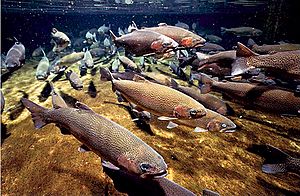
The Hanford Reach is a special part of the Columbia River known for its salmon. When plutonium production ended at Hanford, the areas around the old reactor sites were no longer needed. On June 9, 2000, President Bill Clinton made almost 200,000 hectares (494,000 acres) of the Hanford Site a national monument. The Hanford Reach National Monument is managed to protect its wildlife. In 2000, a fire burned a large part of the monument.
Environmental Concerns at Hanford
From 1944 to 1971, huge amounts of cooling water were pumped from the Columbia River to cool the reactors. Before being released back into the river, the water was held in tanks for a few hours. However, some longer-lasting radioactive materials still entered the river. The government kept this information secret for a long time. Fish from the Columbia River also became contaminated. This especially affected Native American communities who relied on the river for food. Radiation was found as far as 200 miles (320 km) downstream.
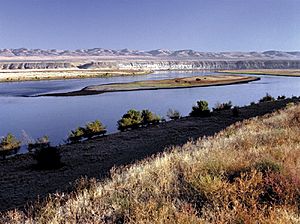
The plutonium separation process also released radioactive materials into the air. These were carried by the wind across Washington and into parts of Idaho, Montana, Oregon, and British Columbia. People living "downwind" were exposed to radioactive substances, especially iodine-131. The biggest releases happened from 1945 to 1951. These substances entered the food chain through dairy cows grazing on contaminated fields, and people who drank the milk or ate the food were affected. Most of these releases were part of normal operations, but some larger releases happened during specific incidents. In 1949, an intentional release called the "Green Run" released 8,000 curies of iodine-131 in two days. A 1992 government report estimated that 685,000 curies of iodine-131 were released into the river and air from Hanford between 1944 and 1947.
Starting in the 1960s, scientists began publishing reports about radioactivity from Hanford. Health departments in Oregon and Washington also raised concerns. In 1985, the DOE started releasing secret environmental records. Reports concluded that people living downwind or using the Columbia River downstream were exposed to higher radiation doses. This put them at increased risk for cancer and thyroid disease. A large lawsuit was filed by two thousand people affected by Hanford's releases. In 2005, some plaintiffs were awarded damages. By 2015, the DOE had paid over $60 million in legal fees and $7 million in damages to settle the cases.
Hanford has 177 underground tanks, and 149 of them are single-shell tanks. These older tanks were designed to last 20 years. By 2005, some liquid waste was moved from single-shell tanks to safer double-shell tanks. However, a lot of radioactive sludge and salt cake remains in the older tanks. It's believed that up to six of these "empty" tanks are leaking. In February 2013, Washington Governor Jay Inslee announced that one tank was leaking about 150 to 300 gallons (568 to 1,136 L) per year. He later stated that six more tanks were leaking.
Cleanup Efforts at Hanford
Organizing the Cleanup
Decades of making nuclear materials left behind 53 million gallons (200 million L) of highly radioactive waste in 177 storage tanks. There's also 25 million cubic feet (708,000 m3) of solid radioactive waste and areas of contaminated groundwater. On June 25, 1988, the Hanford Site was divided into four areas and added to the National Priorities List for cleanup.
On May 15, 1989, the Washington Department of Ecology (WSDE), the United States Environmental Protection Agency (EPA), and the DOE signed the Tri-Party Agreement. This agreement set up a legal plan for cleaning up Hanford. By 2014, it was the world's largest environmental cleanup. The cleanup aims to restore the Columbia River area, prepare the central plateau for long-term waste storage, and get ready for the future.
In 2011, the DOE moved most of the liquid waste from 149 single-shell tanks into 28 newer double-shell tanks. But solid waste (salt cake and sludge) remained. The DOE later found water leaking into at least 14 single-shell tanks, and one had been leaking about 640 gallons (2,423 L) per year since 2010. In 2012, a double-shell tank also leaked due to construction flaws. The DOE now monitors the tanks regularly. In March 2014, the DOE announced delays in building the Waste Treatment Plant, which affects the schedule for removing waste from the tanks.
The DOE manages the cleanup, with oversight from the WSDE and EPA. The citizen-led Hanford Advisory Board gives advice from community groups, including local governments, environmental groups, businesses, and Native American tribes. For Native Americans, the cleanup is also about their moral and religious connection to the land. They focus on protecting local plants and animals, like the Umtanum desert buckwheat, which grows only there and is used for medicine.
Cleanup Activities
In 2014, the estimated cost to finish the Hanford cleanup was $113.6 billion. This means over $3 billion per year for six years, and then about $2 billion per year until 2046.
The cleanup was supposed to be done in 30 years, but by 2008, it was less than half finished. Only one of the four areas listed as Superfund sites in 1989 has been removed from the list. New discoveries of contamination have slowed things down and increased costs. The cleanup was still ongoing in 2023, with over 10,000 workers.
The biggest challenge is dealing with the 53 million gallons (200 million L) of high-level radioactive waste in the 177 underground tanks. By 1998, about a third of these tanks had leaked waste into the soil and groundwater. By 2008, most liquid waste was moved to safer double-shell tanks. However, 2.8 million gallons (10.6 million L) of liquid waste and 27 million gallons (102 million L) of salt cake and sludge remain in the single-shell tanks. The DOE doesn't know how long the double-shell tanks can safely store waste. The waste was supposed to be removed by 2018, but the new deadline is 2040. By 2008, 1 million gallons (3.8 million L) of radioactive waste was moving through the groundwater towards the Columbia River. This waste is expected to reach the river in 12 to 50 years if the cleanup doesn't stay on schedule.
Lower-level hazardous wastes are buried in large, lined pits that will be sealed and monitored. Dealing with plutonium and other high-level wastes is much harder and is still being debated. For example, plutonium-239 has a half-life of 24,100 years. It needs to decay for ten half-lives before it's considered safe. In 2000, the DOE hired Bechtel to build a vitrification plant. This plant will combine dangerous wastes with glass to make them stable. Construction started in 2002. The plant was supposed to be ready by 2011, with vitrification finished by 2028.
A 2012 study found serious technical and management problems. In 2013, the estimated cost was $13.4 billion, with operations starting in 2022. Another leak was reported in April 2021.
As of 2023, 60 square miles (155 km2) of the site's groundwater is still contaminated above federal standards. This is a reduction from 80 square miles (207 km2) in the 1980s.
| Date begun | Organization | Responsibility | Notes |
|---|---|---|---|
| December 12, 1942 | U.S. Army Corps of Engineers | Lead U.S. Government entity | Managed the site until January 1, 1947 |
| December 12, 1942 | E. I. DuPont de Nemours & Company (DuPont) | All site activities | First Hanford site contractor |
| September 1, 1946 | General Electric Company (GE) | All site activities | Replaced DuPont |
| January 1, 1947 | Atomic Energy Commission | Lead U.S. Government entity | Replaced U.S. Army Corps of Engineers |
| May 15, 1953 | Vitro Engineers | Hanford Engineering Services | Took over GE's new facility design role |
| June 1, 1953 | J. A. Jones Construction | Hanford Construction Services | Took over GE's construction role |
| January 1, 1965 | U.S. Testing | Environmental & bioassay testing | Took over GE's environmental and bioassay testing role |
| January 4, 1965 | Battelle Memorial Institute | Pacific Northwest Laboratory (PNL) | Took over GE's laboratory operations – later renamed Pacific Northwest National Laboratory |
| July 1, 1965 | Computer Sciences Corporation (CSC) | Computer services | New area of work |
| August 1, 1965 | Hanford Occupational Health Foundation | Industrial Medicine | Took over GE's industrial medicine role |
| September 10, 1965 | Douglas United Nuclear | Single pass reactor operations & fuel fabrication | Took over part of GE's reactor operations |
| January 1, 1966 | Isochem | Chemical processing | Took over GE's chemical processing operations |
| March 1, 1966 | ITT Federal Support Services, Inc. | Support services | Took over support services |
| July 1, 1967 | Douglas United Nuclear | N Reactor operation | Took over the rest of GE's reactor operations |
| September 4, 1967 | Atlantic Richfield Hanford Company | Chemical Processing | Replaced Isochem |
| August 8, 1967 | Hanford Environmental Health Foundation | Industrial Medicine | Only a name change |
| February 1, 1970 | Westinghouse Hanford Company | Hanford Engineering Development Laboratory | Created from PNL to build the Fast Flux Test Facility |
| September 1971 | ARHCO | Support Services | Replaced ITT/PSS |
| April 1973 | United Nuclear Industries, Inc. | All production reactor operations | Name change from Douglas United Nuclear |
| January 1, 1975 | Energy Research and Development Administration (ERDA) | Lead U.S. Government entity | Replaced AEC – managed site until October 1, 1977 |
| October 1, 1975 | Boeing Computer Services (BCS) | Computer services | Replaced CSC |
| October 1, 1977 | U.S. Department of Energy (DOE) | Lead U.S. Government Agency | Replaced ERDA – manages site currently |
| October 1, 1977 | Rockwell Hanford Operations (RHO) | Chemical Processing & Support Services | Replaced ARCHO |
| June 1981 | Braun Hanford Company (BHC) | Architect & Engineering Services | Replaced Vitro |
| March 1982 | Kaiser Engineering Hanford (KEH) | Architect & Engineering Services | Replaced BHC |
| March 1, 1987 | KEH | Construction | Combined contract includes former J. A. Jones work |
| June 29, 1987 | WHC | Site management & operations | Combined contract includes former RHO, UNC & KEH work. |
| October 1, 1996 | Fluor Daniel Hanford, Inc. (FDH) | Site management & operations | FDH is the main contractor with 13 subcontracted companies |
| February 7, 2000 | Fluor Hanford | Site cleanup operations | Shifted to site cleanup (13 Fluor subcontractors had various roles) |
| December 11, 2000 | Bechtel National, Inc. | Engineering, construction, and commissioning of the Waste Treatment Plant | |
| October 1, 2008 | Ch2M Hill Plateau Remediation Company | Central plateau cleanup and closure | |
| April 8, 2009 | Washington Closure Hanford | River corridor cleanup and closure | |
| May 26, 2009 | Mission Support Alliance | Site infrastructure and services | Combined services contract |
| October 1, 2009 | Washington River Protection Solutions | Tank Farm operations |
|
See also
 In Spanish: Hanford Site para niños
In Spanish: Hanford Site para niños


